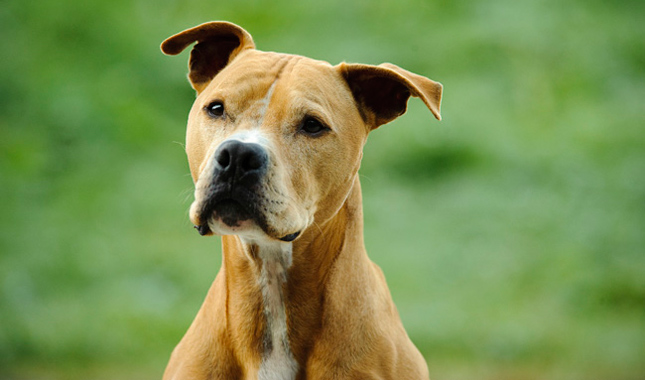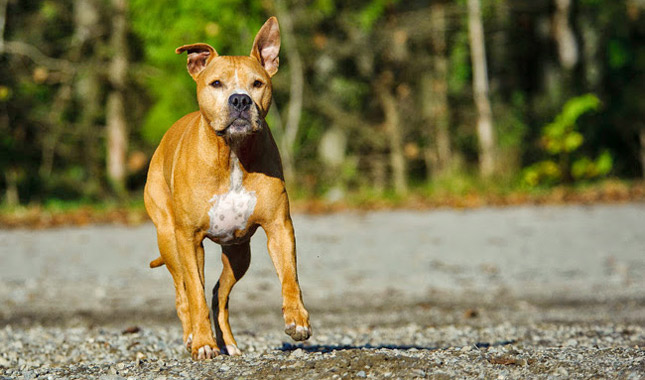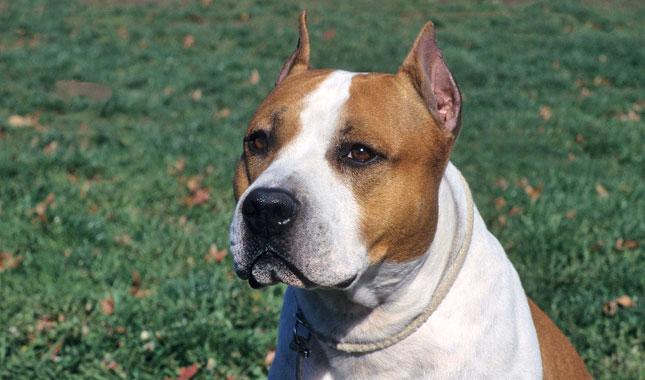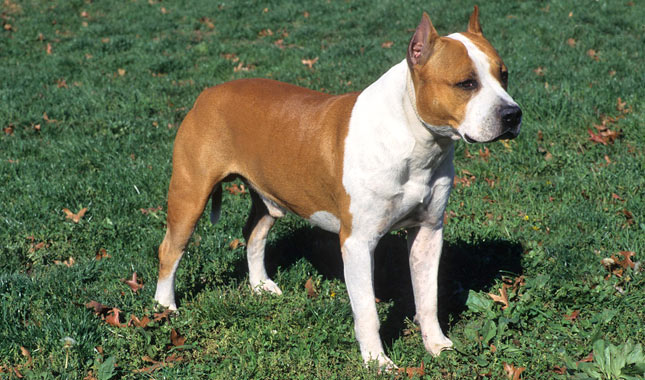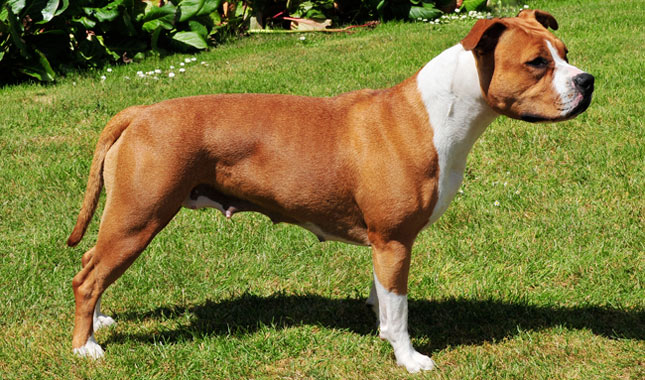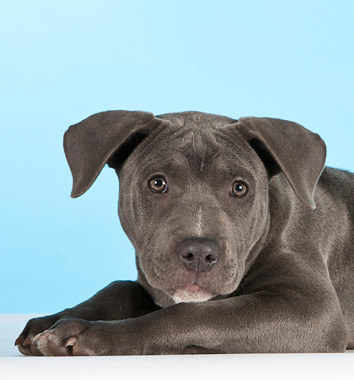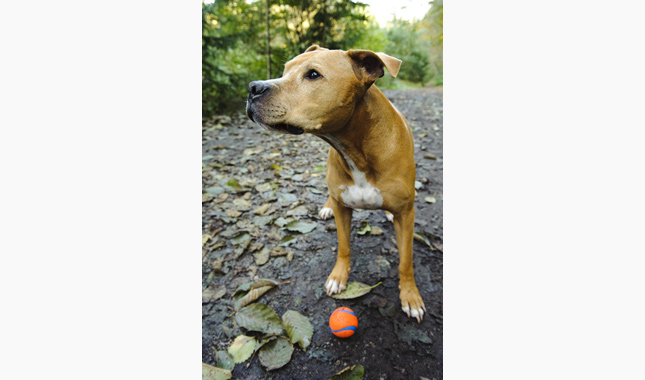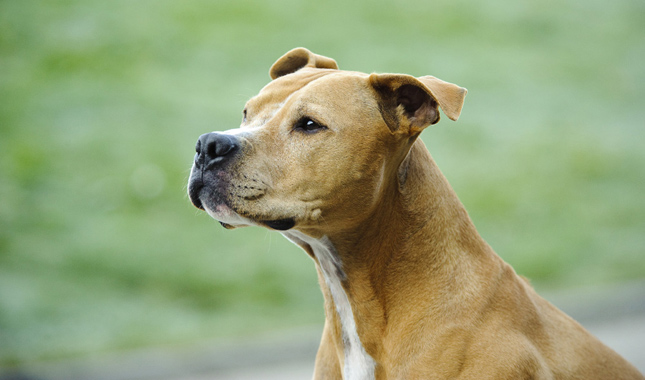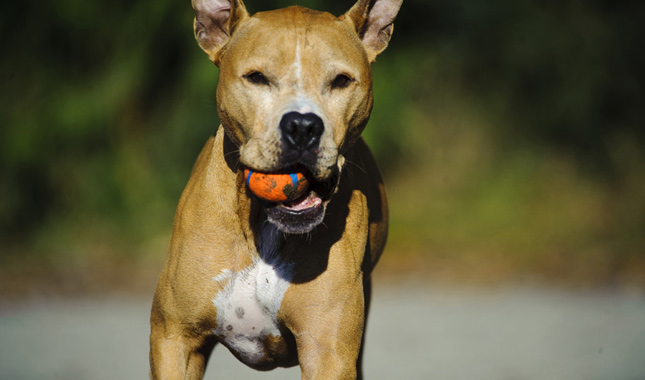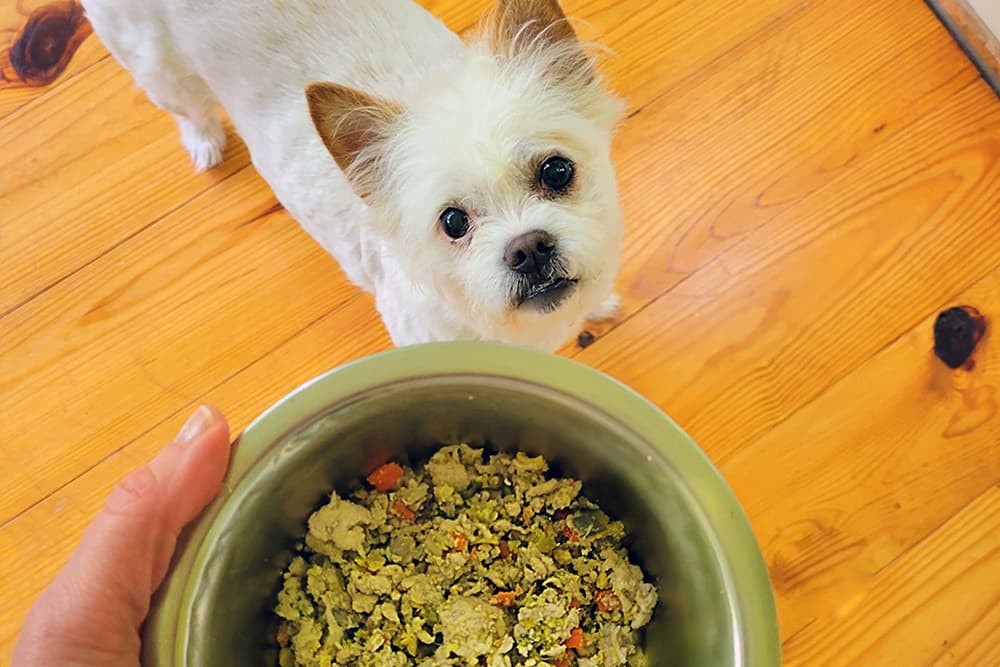American Staffordshire Terrier / American Pit Bull Terrier
Published on July 03, 2011
Breed Details
- Height: 17 to 19 inches at the shoulder
- Weight: 50 to 60 pounds
Breed Characteristics
Adaptability
Trainability
Grooming
Apartament Friendly
Child Friendly
Shedding Level
Dog Friendly
Exercise Needs
Territorial
Barking Tendencies
Health Issues
Social Needs
Energy Level
Affectionate
Watchdog Instincts
Cat Friendly
Intelligence
Stranger Friendly
The Am Staff, as he is nicknamed, looks formidable, but he has been bred for decades to love and accept people. The Am Staff and the American Pit Bull Terrier (APBT) used to be considered one and the same, but they now have different bloodlines. In the right home, they are wonderful companions, but they come with societal baggage. Because they are so similar, we are covering both of these breeds together in this article. American Staffordshire Terriers and American Pit Bull Terriers are the two main breeds usually considered to be “pit bulls.” Once the very icon of American doghood, their tremendous loyalty, tenacity, and bold nature have been exploited by dog fighting rings. But in the hands of loving owners and given the right amount of socialization, training, attention, and love, they are docile, affectionate family dogs.
Before getting one of these dogs, it is important to realize that there is much misinformation around the natures of pit bulls and there are campaigns to outlaw the dogs. Check into local ordinances carefully to be sure that you can legally own one of these dogs in your town. Also do your own research so you can help educate friends and neighbors about the merits of this breed.
Although he’s not among the largest of dogs, an American Staffordshire Terrier can weigh up to 75 pounds, the APBT usually under 60 — most of it muscle. They are powerful dogs and can be a challenge to walk on a leash if not well-trained. Pulling is one of the things these dogs love best. It’s a good idea to channel that desire into a dog sport such as weight-pulling.
Pit bulls are very people-oriented dogs, but with other dogs and small furry creatures, it’s a very different story. There are pit bulls, and dogs that look like pit bulls, that have become friends with the cats in the household and who love every dog they meet, but it’s not typical of the breed. If you want a dog you can take to the park who will play nicely with the other pets there, choose a different breed.
The grooming needs of the pit bull are modest. Brush his coat a couple of times a week to keep shedding to a minimum, and make sure his ears are clean and his nails are trimmed.
Other Quick Facts
- There is no breed with the name “Pit Bull.” When that term is used, it’s usually referring to either American Staffordshire Terriers or American Pit Bull Terriers, and sometimes to the Staffordshire Bull Terrier, a British breed. It’s also a label given to any dog who resembles those breeds, even if that dog is a Lab mix and has little or no “pit bull” in his background.
- Am Staffs and APBTs are typical terriers and like to dig and pull. They are also aggressive chewers. Protect your belongings by putting them away and your yard by giving your dog his own special place to dig.
- Am Staffs and APBTs are athletic and make excellent partners for joggers, runners and cyclists.
- Am Staffs and APBTs do well in such dog sports as obedience trials, agility trials, rally, tracking, drafting (pulling carts or wagons) and freestyle (dancing with dogs). Many enjoy swimming and retrieving.
- The Am Staff and APBT are active, confident dogs. They need early socialization and training to be their best.
- Am Staffs and APBTs are vocal and will make all kinds of unusual noises in their attempts to communicate with you.
- It can be difficult or impossible to purchase homeowner’s insurance if you own certain breeds, including Am Staffs and APBTs. Investigate local laws and ordinances before you acquire one of these dogs.
- Owning an Am Staff or APBT is a huge responsibility, one that cannot be easily given away if you decide this isn’t the dog for you. Be sure you are making the right decision before you get one.
The History of the American Staffordshire Terrier / American Pit Bull Terrier
Back in the somewhat less civilized era of American history, dog fighting was a legal and popular activity. Wealthy people and prominent politicians could be found at the dog fights, betting on their dogs, which went by several names: pit bull, Yankee terrier, half and half dog — a reference to their origin as a cross between bulldogs and terriers.
The same dogs were equally popularly with farmers and families. They were good ratters, useful in hunting dangerous wild pigs and bears, and they loved people. Pit bulls could do it all, from being the kids’ playmate to serving in the military. Sergeant Stubby was a World War I hero, the most decorated dog in American military history.
In 1936, the American Kennel Club accepted the pit bull for registration, giving the dogs the name Staffordshire Terrier. In 1972, it was changed to American Staffordshire Terrier. The breed standards for the Am Staff and the APBT (which is recognized by the United Kennel Club) are almost identical, but the bloodlines no longer mix. The Am Staff ranks 70th among the breeds registered by the AKC, dropping only slightly from 65th a decade ago.
American Staffordshire Terrier / American Pit Bull Terrier Temperament and Personality
From his earliest days as a farm dog to when he was bred for dog fighting, the pit bull in America has always been a sturdy, muscular dog with a short coat, a playful nature, and an unquenchable spirit. Whatever else those old dog fighting breeders did, they created a dog that is extremely resilient and stable, as well as very friendly to people. That’s why so many pit bulls, even from the worst backgrounds, go on to being loving, trustworthy family dogs.
One of the misconceptions about Am Staffs and APBTs is that they are vicious guard dogs. Hardly. They might look scary, and that serves them well as far as intimidating potential intruders, but the real truth is that these dogs love just about everybody. When it comes to being a guard dog, well, they’re just a little too outgoing to succeed. With their families, they’re not quite aware of their size and will often attempt to squeeze into a lap for some loving.
Nonetheless, even carefully bred AmStaffs and APBTs are strong, determined, and smart dogs, and backing down is not part of their normal behavior. That the pit bull is some kind of dual-personality dog ready to switch from a loving pet to a killer in an instant is generally unwarranted, but like all dogs, he needs to be trained and socialized.
Am Staffs and APBTs are typical terriers, and even dogs from show backgrounds are far more likely to be fighters than lovers when it comes to other dogs, especially of the same gender. It’s best not to keep intact males together or to take these dogs to dog parks where they are allowed to run loose. Whether an Am Staff or APBT will get along with other dogs in public varies by individual dog. Some are friendly; others, not so much. And all are likely to view cats and other small furry animals as prey.
He doesn’t just need a little love; dogs from fighting backgrounds or other troubling situations need expert evaluation and, usually, rehabilitation. Sadly, some dogs from fighting backgrounds must be put down, only because they were abused and no longer trust people, or because they are simply doing what they were trained to do. While many of these dogs can be rehabilitated, they are not the best choice for families with young children.
Whether your pit bull is from a breeder or a rescue group, a puppy or an adult, you’ll need to show him a lot of love while still making sure he sees you as a strong, confident leader. He’s a pushy kind of dog, and if you let him, he’ll walk all over you.
Start training your puppy the day you bring him home. Even at eight weeks old, he is capable of soaking up everything you can teach him. Don’t wait until he is 6 months old to begin training or you will have a more headstrong dog to deal with. If possible, get him into puppy kindergarten class by the time he is 10 to 12 weeks old, and socialize, socialize, socialize. However, be aware that many puppy training classes require certain vaccines (like kennel cough) to be up to date, and many veterinarians recommend limited exposure to other dogs and public places until puppy vaccines (including rabies, distemper and parvovirus) have been completed. In lieu of formal training, you can begin training your puppy at home and socializing him among family and friends until puppy vaccines are completed.
Pit bulls don’t do well if they’re left along for long periods, and are not happy as backyard dogs. Let him live as a member of your family or you might find yourself with a lonely, bored, noisy, and destructive nuisance instead of a happy, well-behaved companion.
What You Need To Know About American Staffordshire Terrier / American Pit Bull Terrier Health
All dogs have the potential to develop genetic health problems, just as all people have the potential to inherit a particular disease. Run, don’t walk, from any breeder who does not offer a health guarantee on puppies, who tells you that the breed is 100 percent healthy and has no known problems, or who tells you that her puppies are isolated from the main part of the household for health reasons. A reputable breeder will be honest and open about health problems in the breed and the incidence with which they occur in her lines.
In the hopes of controlling the genetic diseases that already affect the AmStaff and preventing any new ones from emerging, the Staffordshire Terrier Club of America, which is the American Kennel Club parent organization for the breed in the United States, participates in a program operated by the Canine Health Information Center (CHIC). Breeders who wish to have a dog CHIC-certified must test him for heart, thyroid, neurological and hip diseases that occur in the breed. It is advisable to use these guidelines as well for the APBT. Your puppy’s breeder should have written documentation from the Orthopedic Foundation for Animals (OFA) or the University of Pennsylvania (PennHip) that your puppy’s parents’ hips are free of dysplasia, a genetic hip deformity that may require costly surgery to repair and can lead to arthritis later in life. OFA certification that the parents are free of thyroid and heart disease is also required, as are Optigen test results for an inherited condition known as cerebellar degeneration, which can cause the dog to develop difficulty walking. Documentation by the Canine Eye Registration Foundation (CERF) that breeding dogs have had their eyes tested within the past year and OFA evaluations of their elbows are recommended but not required as part of the CHIC program.
Breeders must agree to have all test results, positive or negative, published in the CHIC database. A dog need not receive good or even passing scores on the evaluations to obtain a CHIC number, so CHIC registration alone is not proof of soundness or absence of disease, but all test results are posted on the CHIC website and can be accessed by anyone who wants to check the health of a puppy’s parents.
American Staffordshire Terriers can also suffer from some types of cancer as well as allergies, and progressive retinal atrophy.
Remember that after you’ve taken a new puppy into your home, you have the power to protect him from one of the most common health problems: obesity. Keeping an Am Staff or APBT at an appropriate weight is one of the easiest ways to extend his life. Make the most of your preventive abilities to help ensure a healthier dog for life.
The Basics of American Staffordshire Terrier / American Pit Bull Terrier Grooming
The grooming needs of the pit bull are modest. Brush his coat a couple of times a week to keep shedding to a minimum.
The rest is basic care. Trim the nails as needed, usually once a month. Brush the teeth frequently for good overall health and fresh breath. Check the ears weekly for dirt, redness or a bad odor that can indicate an infection. If the ears look dirty, wipe them out with a cotton ball dampened with a gentle ear cleaner recommended by your veterinarian.
Choosing a American Staffordshire Terrier / American Pit Bull Terrier Breeder
Because Am Staffs and APBTs are associated with fighting, however undeservedly, they attract people who want a “macho” dog. Reputable breeders must place puppies carefully to ensure that they go to appropriate homes. They look for people who are experienced with large dogs, who have securely fenced yards and who understand the responsibilities of caring for a dog with this reputation.
Research breeders carefully and meet one or both of the puppy’s parents. The breeder should be someone you trust to have given a puppy the best start in life, not only through good nutrition and socialization, but also by breeding temperament-tested parents with health clearances.
Adopting a Dog From a American Staffordshire Terrier or a American Pit Bull Terrier Rescue or Shelter
Take your search for a knowledgeable, responsible breed rescue organization seriously. The dogs should have been evaluated and made available for adoption only to suitable homes. If they tell you a particular dog isn’t right for you, believe them, and keep looking.
Whether you’re planning to get your new best friend from a breeder, a pet store, or another source, don’t forget that old adage “let the buyer beware”. Disreputable breeders and facilities that deal with puppy mills can be hard to distinguish from reliable operations. There’s no 100% guaranteed way to make sure you’ll never purchase a sick puppy, but researching the breed (so you know what to expect), checking out the facility (to identify unhealthy conditions or sick animals), and asking the right questions can reduce the chances of heading into a disastrous situation. And don’t forget to ask your veterinarian, who can often refer you to a reputable breeder, breed rescue organization, or other reliable source for healthy puppies.
There is certainly no shortage of pit bulls and pit bull-type dogs in America’s shelters and rescue groups, and there is no question you’ll be able to find the right one for your family. Here is how to get started.
1. Use the Web
Sites like Petfinder.com and Adopt-a-Pet.com can have you searching for an Am Staffs or APBT in your area in no time flat. The site allows you to be very specific in your requests (housetraining status, for example) or very general (all the pit bull-type dogs available on Petfinder across the country). AnimalShelter can help you find animal rescue groups in your area. Also some local newspapers have “pets looking for homes” sections you can review.
Social media is another great way to find a dog. Post on your Facebook page that you are looking for a specific breed so that your entire community can be your eyes and ears.
2. Reach Out to Local Experts
Start talking with all the pet pros in your area about your desire for an Am Staffs or APBT. That includes vets, dog walkers, and groomers. When someone has to make the tough decision to give up a dog, that person will often ask her own trusted network for recommendations.
3. Talk to Breed Rescue
Most people who love pit bulls love all pit bulls. That’s why breed clubs have rescue organizations devoted to taking care of homeless dogs. The Staffordshire Terrier Club of America’s Rescue Network can help you find a dog that may be the perfect companion for your family. You can also search online for other Am Staffs or APBT rescues in your area.
The great thing about breed rescue groups is that they tend to be very upfront about any health conditions the dogs may have and are a valuable resource for advice. They also often offer fostering opportunities so, with training, you could bring a Am Staffs or APBT home with you to see what the experience is like.
4. Key Questions to Ask
You now know the things to discuss with a breeder, but there are also questions you should discuss with shelter or rescue group staff or volunteers before you bring home a pup. These include:
- What is his energy level?
- How is he around other animals?
- How does he respond to shelter workers, visitors and children?
- What is his personality like?
- What is his age?
- Is he housetrained?
- Has he ever bitten or hurt anyone that they know of?
- Are there any known health issues?
Wherever you acquire your Am Staffs or APBT, make sure you have a good contract with the seller, shelter, or rescue group that spells out responsibilities on both sides. Petfinder offers an Adopters Bill of Rights that helps you understand what you can consider normal and appropriate when you get a dog from a shelter. In states with “puppy lemon laws,” be sure you and the person you get the dog from both understand your rights and recourses.
Puppy or adult, a breeder purchase or a rescue, take your Am Staffs/APBT to your veterinarian soon after adoption. Your veterinarian will be able to spot problems and will work with you to set up a preventive regimen that will help you avoid many health issues.

